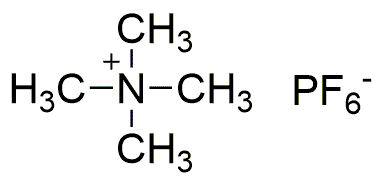Tetramethylammonium hexafluorophosphate is widely utilized in research focused on:
- Electrolytes in Batteries: This compound serves as an effective electrolyte in lithium-ion batteries, enhancing conductivity and stability, which is crucial for improving battery performance in consumer electronics.
- Organic Synthesis: It acts as a phase-transfer catalyst in various organic reactions, facilitating the transfer of reactants between different phases, thereby increasing reaction efficiency in pharmaceutical and chemical manufacturing.
- Ion Conductors: Used in solid-state ion conductors, it plays a vital role in the development of advanced materials for fuel cells, contributing to cleaner energy solutions.
- Analytical Chemistry: This compound is employed in ion chromatography and mass spectrometry, aiding in the precise analysis of ionic species in environmental samples, which is essential for regulatory compliance and environmental monitoring.
- Electrochemical Sensors: It is utilized in the fabrication of electrochemical sensors, improving sensitivity and selectivity for detecting various analytes, which is beneficial in food safety and medical diagnostics.
General Information
Properties
Safety and Regulations
Applications
Tetramethylammonium hexafluorophosphate is widely utilized in research focused on:
- Electrolytes in Batteries: This compound serves as an effective electrolyte in lithium-ion batteries, enhancing conductivity and stability, which is crucial for improving battery performance in consumer electronics.
- Organic Synthesis: It acts as a phase-transfer catalyst in various organic reactions, facilitating the transfer of reactants between different phases, thereby increasing reaction efficiency in pharmaceutical and chemical manufacturing.
- Ion Conductors: Used in solid-state ion conductors, it plays a vital role in the development of advanced materials for fuel cells, contributing to cleaner energy solutions.
- Analytical Chemistry: This compound is employed in ion chromatography and mass spectrometry, aiding in the precise analysis of ionic species in environmental samples, which is essential for regulatory compliance and environmental monitoring.
- Electrochemical Sensors: It is utilized in the fabrication of electrochemical sensors, improving sensitivity and selectivity for detecting various analytes, which is beneficial in food safety and medical diagnostics.
Documents
Safety Data Sheets (SDS)
The SDS provides comprehensive safety information on handling, storage, and disposal of the product.
Product Specification (PS)
The PS provides a comprehensive breakdown of the product’s properties, including chemical composition, physical state, purity, and storage requirements. It also details acceptable quality ranges and the product's intended applications.
Certificates of Analysis (COA)
Search for Certificates of Analysis (COA) by entering the products Lot Number. Lot and Batch Numbers can be found on a product’s label following the words ‘Lot’ or ‘Batch’.
*Catalog Number
*Lot Number
Certificates Of Origin (COO)
This COO confirms the country where the product was manufactured, and also details the materials and components used in it and whether it is derived from natural, synthetic, or other specific sources. This certificate may be required for customs, trade, and regulatory compliance.
*Catalog Number
*Lot Number
Safety Data Sheets (SDS)
The SDS provides comprehensive safety information on handling, storage, and disposal of the product.
DownloadProduct Specification (PS)
The PS provides a comprehensive breakdown of the product’s properties, including chemical composition, physical state, purity, and storage requirements. It also details acceptable quality ranges and the product's intended applications.
DownloadCertificates of Analysis (COA)
Search for Certificates of Analysis (COA) by entering the products Lot Number. Lot and Batch Numbers can be found on a product’s label following the words ‘Lot’ or ‘Batch’.
*Catalog Number
*Lot Number
Certificates Of Origin (COO)
This COO confirms the country where the product was manufactured, and also details the materials and components used in it and whether it is derived from natural, synthetic, or other specific sources. This certificate may be required for customs, trade, and regulatory compliance.


